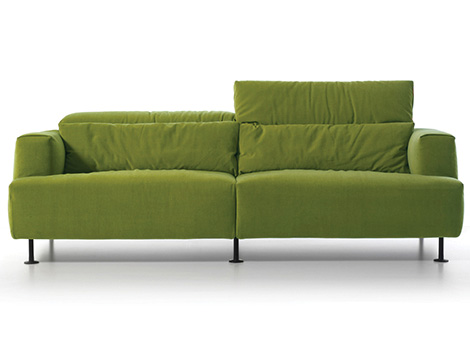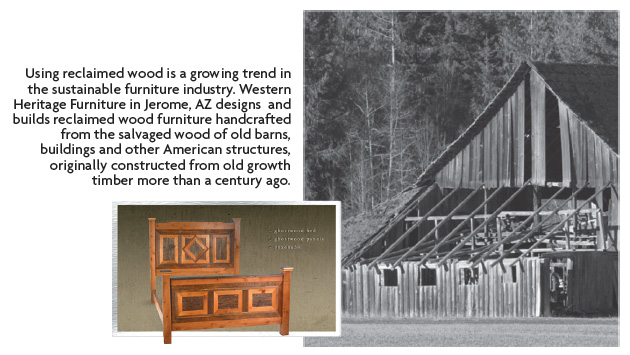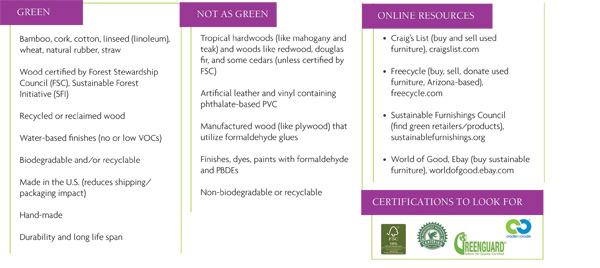BY AIMEE WELCH

When people set out to buy a new couch, bed or kitchen table, the list of criteria probably includes things like price, comfort, style and maybe even brand. In a nutshell, we want our furniture to look and feel good, at a price within our budget. For some people, Pottery Barn or a high-end specialty store is the first stop. For others—who may still live with marker-wielding “toddler-artists” or those just looking for a smokin’ deal—Craig’s List or IKEA are excellent choices. Either way, whether we realize it or not, some choices are “greener” than others when it comes to furniture. Yes, even the chairs you sit on have a carbon “footprint.”
For the environmentally conscious, how and where that chair was made should be making its way onto your furniture-buying list of criteria. From the materials and finishes used in manufacturing, to the construction and transportation energy required to get it to market, to that loyal coffee table’s ultimate destination—as a non-biodegradable piece of trash in an overcrowded landfill, an antique in the living room of a great grandchild, or an entirely new product—furniture has a life cycle that impacts the environment and your health.
Historically, that life cycle hasn’t made the furniture industry a lot of “green” friends. Associations with illegal logging and rainforest destruction, child labor usage, air and water pollution, and unhealthy VOC-emitting finishes have plagued the industry. And, according to the Environmental Protection Agency (EPA), furniture accounted for more than 8.8 million tons of municipal waste (3.6 percent) in 2005—more than any other durable goods. Because the majority of furniture manufacturing has been outsourced to countries where environmental and labor laws are remiss, making positive changes continues to be a challenge.
Fortunately, change is on the horizon. New standards, certifications and laws impacting sustainable furniture are cropping up, consumer demand is increasing, and manufacturers and retailers around the world are providing consumers with more education, and more affordable “green” furniture options.
Why buy sustainable furniture?
Bottom line, the vast majority of non-green couches (and chairs, beds, armoires, shelves, etc.) are harmful to the environment and your health. Consider this—every year about 32 million acres of timber around the world are lost to legal and illegal logging, according to Smithsonian.com, and approximately 80% of the world’s rainforests have been degraded or destroyed, much of it within the last 50 years. Many of those trees are being used to make furniture. We’re killing endangered, life-sustaining, global-warming defending forests to make…tables and chairs. Someone’s going on the “Naughty List” this holiday.
Also, approximately 90% of furniture is now made overseas, where there are fewer restrictions regarding air and water pollution, labor and responsible forest management, according to The Economist. The process is high on transportation (which adds to CO2 emissions) and, in many cases, lower in quality, which means it ends up in a landfill sooner rather than later. VOC-emitting finishes, paints, dyes and textiles contribute to indoor air pollution, and are linked with many health problems, especially in children. Even more alarming, there are very few safeguards in place to ensure consumers get the full scoop on that couch before it ends up in the living room—basically you could be sitting on an “endangered” couch that is emitting all kinds of potentially harmful chemicals, but the tag just says “Made in China, Finished in U.S.A.” Huh?
 It’s not that governments and non-profits aren’t trying to help. An abundance of domestic and international agreements and laws exist to protect the forests—it’s just that not everyone is following them. For example, much of the wood used for mahogany furniture is illegally harvested in the Amazon Rainforest, according to a press release issued by the Sustainable Furnishings Council. The process is deeply rooted in corruption, complete with fraudulent documents that make it all appear legal. That means retailers around the world are unknowingly (or not) selling furniture made from endangered rainforest wood, and consumers are unknowingly buying it.
It’s not that governments and non-profits aren’t trying to help. An abundance of domestic and international agreements and laws exist to protect the forests—it’s just that not everyone is following them. For example, much of the wood used for mahogany furniture is illegally harvested in the Amazon Rainforest, according to a press release issued by the Sustainable Furnishings Council. The process is deeply rooted in corruption, complete with fraudulent documents that make it all appear legal. That means retailers around the world are unknowingly (or not) selling furniture made from endangered rainforest wood, and consumers are unknowingly buying it.
And when it’s reached the end of its useful life, that non-green couch can’t be reused or recycled, because it fell apart, and it will end up in the landfill, with millions of tons of other garbage.
What makes a green couch “green?”
There isn’t one governing body that certifies a piece of furniture “green,” the way the U.S. Department of Agriculture does for organic food, but rather many different shades of green for consumers to decipher. It’s still a work in progress, but in the meantime, here’s a simplified guideline to help you find furniture made with the environment and your health at heart.
Materials: Whether the wood from your couch came from a demolished building, an old orchard, or beams from a historic barn, taking what’s old and making it new again is a very green practice. Green couches are made with materials that are recycled or re-purposed, renewable and safe. For new couches, the greenest are built from FSC-certified or local hardwood, or renewable resources like bamboo or mango; use of glues, sealants and formaldehyde is minimal; its cushions made from 100% natural latex foam wrapped with wool and a fire-barrier cloth; and its fabric from hemp, linen and organic textiles grown with minimal pesticides; and any finishes used are free of volatile organic compounds (VOCs).
Manufacturing Process: The process by which a product is made also contributes to its “green couch” status. Questions to consider during your research: Does the manufacturing plant use renewable energy sources, is it run efficiently and carefully in terms of conserving natural resources and minimizing pollution, are employees treated well and compensated fairly, and is the ultimate product durable and easily recycled, as to not take up space in a landfill at the end of its life? Is it sourced and made in the U.S. or Europe (which generally adhere to stricter guidelines and safer practices)? The more yeses, the greener the process.
Transportation Energy and Packing: Shipping furniture from overseas requires a lot of energy, which equals a lot of extra carbon dioxide in the air, as well as the packing materials required to pack and ship it. The most eco-friendly way to purchase furniture is to buy locally produced furniture built from locally sourced materials. But even if furniture comes from far away, some packing and shipping methods are more efficient and environmentally friendly than others, such as “flat-packing” (shipping furniture in flat boxes to reduce capacity) and using recyclable materials for packing.
Longevity and use: The more durable a piece of furniture is, the longer someone will be able to use it in some capacity, keeping it out of a landfill. High-quality furniture can be passed down through generations, resold and refurbished for years and years. Furniture with a short life, on the other hand, has to be replaced more often, which starts the entire process over, increasing pressure on natural resources. Green furniture, when it inevitably reaches the end of its useful life, is recyclable or even biodegradable.
Green steps forward in the furniture industry
Since “illegally harvested from an endangered rainforest” isn’t likely to show up on any label, but many other cryptic eco-friendly claims are, consumers are sometimes left scratching their heads. Is it green or not? Help is on the way, in the form of government mandates and non-profit third-party organizations and certifications that will keep everyone better informed, as well as retailers and manufacturers that are implementing greener practices. Here is a just a handful of key players and steps in the industry’s move toward greener furniture and practices.
The Sustainable Furnishings Council (SFC) is a North Carolina-based non-profit alliance of furniture-industry professionals established in 2006 to promote sustainable practices among manufacturers, retailers, and consumers. The membership organization is a great resource for industry professionals and consumers dedicated to sustainability, offering an in-store tagging program which identifies retailers and products that exceed their sustainability standards—which consumers can search for on SFC’s website—as well as network of over 400 members sharing a common objective.
There are also a growing number of certifications for furniture that declare it green, on some level—U.S. Forest Stewardship Council (FSC), Sustainable Forestry Initiative (SFI), American Tree Farm, and Canadian Standards Associations (CSA) all offer forest certification programs, The GREENGUARD Environmental Institute (GEI) certifies products and materials for low chemical emissions, to help enhance indoor air quality, and Cradle to Cradle certification assesses a product’s safety to humans and the environment, and design for future life cycles. And as consumer demand for greener furniture increases, so will green furniture options.
The environmental and human health stakes of logging are so high that in 2008 the amended Lacey Act became the first law in the world to prohibit trading wood products made from illegally harvested trees. Since then, U.S. imports of illegal timber have been falling steadily, but there is still a long way to go. The effort to control illegal logging is an international one and, as a result, the practice has decreased by more than 20%—which equates to about 1 billion tons of CO2 which didn’t reach the atmosphere, according to the SFC. Currently, the most widely used certification is the FSC-certified label which identifies products “sourced from forests managed to the highest environmental, social, and economic standards,” and makes that furniture eligible for LEED Materials and Resources credits.
How to go about buying sustainable furniture
Before you find yourself on the verge of a kitchen table upgrade or ready to replace the finger-painted, chocolate-milk-stained, trampoline stand-in that is your couch, start by asking yourself whether or not that piece of furniture can be refurbished. If you initially bought a quality piece, chances are it can be sanded and painted (using green finishes), reupholstered or refurbished in some green way. If you can recondition it, do it! If you’re really done with it, consider donating or selling it (someone else may be up for the challenge) or, check with your city’s bulk trash department. Many will pick it up and recycle it if possible.
If you are going to shop, consider that the greenest thing to do is check out garage sales, flea markets, secondhand stores and their online equivalents like Freecycle.com and ebay.com to find your furnishing treasures in the rough. People get rid of the darndest things—antiques, heirlooms, and maybe even the sofa table of your dreams—and you’re likely to get what you want at a great price, and with a clear conscience.
If you have your heart set on new furniture, look for credible certifications like FSC and GREENGUARD certified products. You can also find green retailers, manufacturers, designers and suppliers on SFC’s website. Review the “What makes a green couch green?” section and find products that meet as much of that criteria as possible. And make sure whatever you buy is built to last.
You shouldn’t have to go too far off the beaten path to find what you’re looking for…specialty shops aren’t the only places selling sustainable furniture—Crate & Barrel, IKEA, Home Depot, West Elm and Pottery Barn are just a sampling of big retailers responding to consumer demand, and increasing their green selections for furniture and other products. Many furniture stores now offer at least one or two options which are marketed as sustainable, eco-friendly, or some other phrase that triggers your inner eco-obligation. Remember to do your homework before you shop—be cognizant of the many shades of green out there…a lot of furniture claims to be but, in the end, it’s not easy being green furniture.






[…] right now. Furniture brands are focusing on making their products more environmentally-friendly without sacrificing quality. Sustainability is becoming more of a priority among consumers, so the more a brand emphasizes […]
Thanks for this article. A lot of people don’t realize that the majority of wood furniture they buy in furniture stores comes from over seas and how much that is impacting the environment. What happened to the days when people bought quality furniture that lasted a life time and was pasted on. We have too much of a throw away mentality which is just not sustainable nor is it financial wise. I love furniture made from reclaimed woods. Reclaimed wood has so much character verses of buying new furniture that has been made to look artificially age and distressed.
Until reading this article I had always thought that a couch or chair or other household item was simply a piece of furniture. However, these days we need to be thinking more about the environment. This means also considering how that piece of furniture was made and how easy it will be to recycle and dispose of when its usefulness has come to an end.
This article also points out a number of things about the furniture industry that I was not aware of. For example, almost 90 percent of the furniture we buy is made overseas. This also means that many of those producing countries do not have strict (or any) regulations about how the furniture is made.
Yet, the industry does seem to be changing for the better. There is a growing movement to used reclaimed (i.e. recycled) wood and even less environmentally harmful finishes.